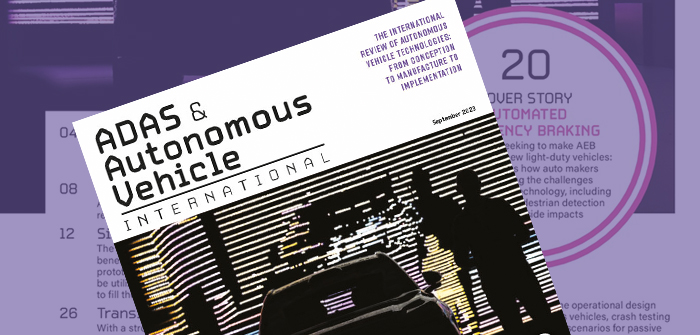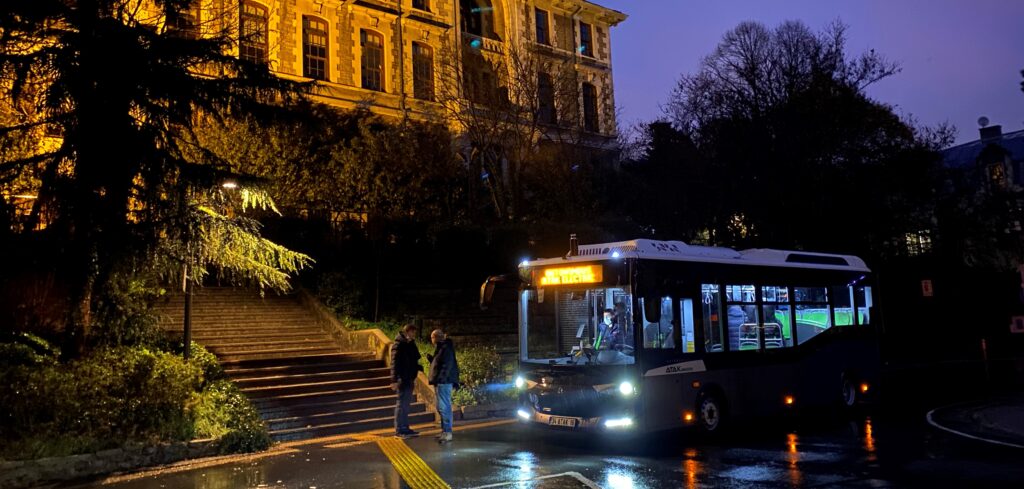AAVI learns how shared intelligent transportation has the potential to enrich communities and solve driver shortages, with autonomous bus and shuttle services in Europe and the US providing valuable lessons
Surprisingly few people are aware that automated public transportation in the form of autonomous buses and shuttles is already a reality, with fleets of driverless vehicles in daily service in both the US and Europe. Adastec Corp is currently operating a full-size (22-seat), electric SAE Level 4-capable automated transit bus on a circular route around Michigan State University’s campus in East Lansing, Michigan. “We have been making 10 daily trips between an outer commuter lot and the auditorium building within the campus, carrying students and faculty for more than one year,” explains Dr Kerem Par, CTO and co-founder of Adastec Corp.
The service is part of an existing public transit network – route 32 of the local operator, CATA, in East Lansing. “This is a 4.6-mile route in open traffic with seven intersections, pedestrian crossings, bicycle lanes and uncontrolled left turns,” continues Par. “Our maximum speed is 25mph [40km/h] and we have a safety driver on board. We began transporting passengers in April 2022. Our deployment at Michigan State University is the first and only full-size Level 4 (L4)automated bus operating on public roads in the US.”
Adastec is also running an autonomous service on public roads in the city of Stavanger in Norway. “Vy, the largest land-based transportation operator in the Nordics, has worked with autonomous shuttles in pilot projects since 2018,” explains Par. “After these experiences, it set its new goals as bigger buses, running at higher speeds, for use on the existing routes. And, ultimately, running without a safety driver or operator. They were in search of such vehicles. They identified us as the best solution.”
An autonomous bus service is now fully integrated into Stavanger’s regular public transportation system, serving an existing 3km route, line 18. The bus operates Monday to Friday from 1:00pm until 8:00pm, making 14 daily trips in seven hours, and has been carrying passengers since May 2022. The bus drives itself from the downtown city center, along the harbor, and to the concert hall.
“Our project in Stavanger is a first of its kind in Europe,” says Par. “Our current maximum speed is 25km/h, and we currently operate with a safety driver on board to overlook the operation.”
The route features several uncontrolled pedestrian crossings and considerable pedestrian traffic as well as roundabouts and uncontrolled intersections. “It is quite a complex environment,” notes Par. “Stavanger is a tourist destination. Especially during summer, many cruise ships visit the city, with thousands of visitors jaywalking and taking photos while shopping around the harbor along our route, making the operation even more challenging.”
A yet more challenging route in Stavanger will open later this year: “It’s between the central railway station and the ferry terminal, and features different characteristics, including a long tunnel,” notes Par. “It will have a maximum speed of 40km/h and we will be able to demonstrate more ODD capabilities.”
The company insists on factory fitting its flowride.ai domain-focused, L4 automated driving system to transit buses to offer an automated solution that can be tailored to suit the needs of individual customers. “Using a factory-fitted and homologated base vehicle improves the vehicle’s reliability and makes it easier to achieve full compliance with safety standards,” says Par.
Adastec’s AD system features two components: flowrideDrive, which is a modular automated driving software that runs on the bus and handles all aspects of the automated operation using sensors and HD maps; and flowrideCloud, which is a cloud-based platform that supports mission control, fleet management and data-sharing operations through APIs.
The self-driving platform utilizes enhanced sensor fusion and deep learning techniques for fault-tolerant operation, pulling data from a sensor suite comprising lidar, RGB cameras, thermal cameras, radar and high-precision GNSS receivers.

Mapping is also critical: “We operate in pre-mapped areas,” says Par. “We generate maps of the areas before deployments. We automatically detect the quality of the map during the operation, and we can update it when needed. We can have multiple and predefined stop locations. We can operate in ‘metro mode’ or ‘on-demand mode’. We can run simulations of the operation before going out to the actual route.”
The company also has access to a sophisticated cloud infrastructure. “We have facilities for data storage, data analysis, reporting, remote monitoring and control of vehicles, over-the-air (OTA) updates, and data sharing through our APIs with third parties for integrating fleet management systems, supervision systems and public transportation operators,” continues Par. “We also have ‘teleoperation’ or remote driving capability already integrated into our product.”
Market opportunity
“Level 4 automated, fully electric, full-size, high-capacity buses can offer a viable option for efficient transportation,” insists Par. “They can be integrated into existing public transit networks, and they can transform public transportation with modern, always available, 24/7, fully accessible and clean public transportation services.”
One of the biggest challenges faced by modern cities is traffic – currently experts are divided on whether the arrival of automated driving will make this problem better or worse. For Par, there could be trouble ahead.
“We have concerns that shared mobility services [robotaxis] may contribute to the congestion problem,” he says. “Additionally, the potential increase in self-driving and autonomous private cars may exacerbate the situation,” he continues. “We believe that implementing automated public transportation could help address the issues of traffic congestion and carbon emissions.”
Public transportation authorities and city mayors have always claimed they can reduce pollution and jams by forcing drivers out of their cars and onto mass transit. However, in too many cities the bus networks are not fully accessible, not always available and not sufficiently clean, in terms of emissions.
There is also a serious driver shortage worldwide: “There are not enough drivers available to operate the buses – not the new ones, even the existing ones,” says Par. “Public transit operators have started canceling some services, reducing the number of trips and reducing service hours. This is a serious problem.”
Par estimates an average of 3.5 drivers are needed to operate a single bus, representing an annual labor cost of approximately US$250,000. “We believe that L4 automated buses will largely eliminate most driver costs,” he says. “Using electric buses also reduces the cost of energy. Automation, using automated electric buses, further optimizes energy efficiency. You can have significant savings in battery range and battery life with efficient automated driving algorithms compared with manually driven electric vehicles.”
Unsurprisingly, an autonomous electric bus costs more than its conventional counterpart, with Par estimating the related sensor suite and software licenses can add between 25-50% to the purchase price. However, he expects technology and software costs to reduce as the industry scales, while emphasizing that the additional up-front expense can be quickly recovered.
“The extra costs can be covered by the reduction in labor costs,” he says. “The per-person technology cost in the case of an automated bus is very low compared with a personally driven autonomous car. Overall, we can say that automated public transportation provides a quicker return on investment compared with other types of autonomous vehicles.”
Easy does it
In November 2021, Toulouse-based EasyMile became the first driverless solutions provider in Europe authorized to operate without any human attendant on board in mixed traffic, on a public road, for an autonomous minibus service on a 600m mixed-traffic route at the Oncopole medical campus in Toulouse in the South of France. The company says its technology can work in any weather conditions, including heavy rain, snow and fog, and in temperatures from -15°C to +45°C.
In October 2022, the company won a public tender worth €4m (US$4.4m) to provide a commercial fleet of autonomous shuttles for fully driverless operation at a Belgian tourist site. The service is set to run seven days a week, for up to 10 years, at the Terhills National Park.
Some 200 of its EZ10 autonomous shuttles, which seat up to 12 passengers, are currently in service in more than 300 locations in 30 countries, across a range of diverse domains, including business parks, airports, communities, factories and industrial sites.
Meanwhile in May this year, EasyMile announced it will work with Renault Group to install its technology on board electric minibuses set to operate on the Châteauroux Métropole public transportation network in France, marking the first deployment of a L4 autonomous mobility service on this scale.
The project, known as Mach2, is a decisive step in the development of automated public transportation in Europe. Operational from 2026 in the center of Châteauroux, in the heart of France, the autonomous shuttles will be integrated into the city’s Horizon bus network, and operated by Keolis, with Alstom providing the connected safety infrastructure and communication protocols.
Olivier Pairot, product and marketing director at EasyMile, emphasizes the emissions reductions that such services can bring: “Cars represent 25% of CO2 emissions in Europe,” he says. “To reduce this, we need to double the number of people that use public transportation.”
He also sees huge latent demand: “More options are sought by adults not only in good health, but also for the elderly, for people with reduced mobility, for children – they all need something more granular that will go door-to-door. At the same time, there is the most critical driver shortage we have ever seen. The market [for autonomous shuttles] is simply immense, and that’s before you factor in the return of investment for operators.”
Overall, EasyMile’s goal is to deliver a service with a total cost of ownership, including cost of operation, 30% lower than a vehicle of a similar size with a human driver.
Why so slow?
Given the clear business case and social benefits of autonomous mass transit, you might be forgiven for asking why progress has been relatively slow. Corey Clothier, an autonomous mobility strategist and founder of Stantec GenerationAV, which works with tech companies, federal agencies and cities to speed AV deployment, has been following the sector since 2012.
“The very early buses would get stuck because of an edge case or problem that was hard for them to manage or handle,” recalls Clothier. “They would just stop, but you can’t do that on a transit run, especially at an airport, where the service needs to run on time and always be available. Nobody wants to be stuck on a bus for 10 minutes because a plastic bag flew by. That’s why there is normally a human-in-the-loop via a remote supervision system to help drive a vehicle around an obstacle or at least check the route and give the vehicle permission to cross to the other side, if clear, and continue.”
He admits that first-generation vehicles also suffered from two major drawbacks – they were too small and they didn’t go fast enough: “We learned in those early days that the transit agencies really needed something a little faster to be able to operate in mixed traffic, as well as a little bigger. Smaller capacity shuttles are fine for campus use, but for popular public transportation routes, you need to carry more passengers.”
The situation is very different today, he says, with full- and midsize vehicles with the right requirements now available. “Transit clients in North America and other parts of the world are asking for mid-speed capabilities of at least 35-45mph [56-72km/h],” continues Clothier. “They must be able to keep up with and maintain the same speed as other traffic. To serve busy routes, they also need to carry at least 20 passengers, with space for at least one but preferably two properly secured wheelchairs.”
EasyMile’s Pairot suggests the regulatory environment needed to support wider public use is now only just emerging. “You need to have a legal framework in place before you can deploy autonomous vehicles at scale,” he says. “This has started to be solved in Europe and in the
US, with regulations now in place, but this has been very recent. In Germany and France, for example, the laws have only been changed over the last six months.”
However, he agrees that vehicle speeds in initial deployments were “definitely too slow to match user expectations”. In response, he says EasyMile has doubled down on performance, but admits the safety implications of urban operation will always restrict speed. “We continue to work on improving the performance of our algorithms and the safety of those algorithms,” says Pairot. “We want to better anticipate the actions of others by seeing further with our sensors. We’ve already taken some big steps forward and there are new sensors coming to the market that will further improve performance. With a safety driver on board, we can drive without any trouble at 40-50km/h. Without a safety driver, at what speed should the vehicle drive so that if someone crosses behind a parked car, they won’t be killed? That’s a very, very tricky question,” he continues.
“We must always consider the worst-case scenario when you have no safety driver on board. That’s why minibuses and shuttles that have been designed to be fully driverless from the very start are significantly slower than other vehicle types, including L3 buses that do not have as strong a business case. However, the average speed of a bus in a city in Europe is currently 17km/h, while the peak is 40km/h, so we believe we can deliver a high-quality service in all city centers and their surrounding suburbs. However, it’s not enough if you want to cover rural areas, where you have to go faster.”
Par at Adastec sounds a similar note of caution: “Currently, our vehicles have a safety driver on board, ensuring that we comply with existing regulations without too much change,” he says. “Additionally, we have implemented fault-tolerant systems by utilizing various compute units and sensors with multiple modalities to cover the same area. This also allows for minimal disruption in our operations,” he continues.
“Of course, the sensors and computational units that we use in the system should be improved to comply with automotive standards. But we are seeing huge investments from hardware manufacturers, automotive Tier 1s and sensor providers toward this goal. Achieving system-wide safety will be an outcome of the partnership of vehicle manufacturers, hardware vendors and technology providers like us.”
Par believes the use of V2X could hold the key, having seen its impact on the company’s Michigan operation: “All intersections along the route are equipped with V2X technology and we communicate with the traffic lights using signal phase and timing (SPaT) information,” he says. “This not only improves rider comfort and energy efficiency, it also allows you to make decisions much more quickly. It could enable better communication with emergency vehicles. Improvements in the road infrastructure and the integration of intelligent roadside equipment will enable automation technology to be scaled up more quickly. This investment is particularly effective and feasible for public transit roads, as their coverage is limited but the benefits are far-reaching.”
Meanwhile, the company continues to work on improving its product and enhancing its ODD capabilities. “Of course, the transition to a fully driverless operation will take time,” says Par. “Our initial belief remains largely unchanged. We anticipate that automation will begin in fleets where the return on investment is more apparent. By 2030, we expect to see fully automated routes in numerous metropolitan cities and airports worldwide.”
Click to read more on mobility solutions
This feature was first published in the September 2023 issue of ADAS & Autonomous Vehicle International magazine – you can find our full magazine archive, here – all magazines are free to read.



